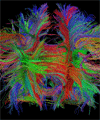December
Brain connections may explain why girls mature faster

Newcastle University scientists have discovered that as the brain re-organises connections throughout our life, the process begins earlier in girls which may explain why they mature faster during the teenage years.
As we grow older, our brains undergo a major reorganisation reducing the connections in the brain. Studying people up to the age of 40, scientists led by Dr Marcus Kaiser and Ms Sol Lim at Newcastle University found that while overall connections in the brain get streamlined, long-distance connections that are crucial for integrating information are preserved.
The researchers suspect this newly-discovered selective process might explain why brain function does not deteriorate – and indeed improves –during this pruning of the network. Interestingly, they also found that these changes occurred earlier in females than in males.
Explaining the work which is being published in Cerebral Cortex, Dr Kaiser, Reader in Neuroinformatics at Newcastle University, says: “Long-distance connections are difficult to establish and maintain but are crucial for fast and efficient processing. If you think about a social network, nearby friends might give you very similar information – you might hear the same news from different people. People from different cities or countries are more likely to give you novel information. In the same way, some information flow within a brain module might be redundant whereas information from other modules, say integrating the optical information about a face with the acoustic information of a voice is vital in making sense of the outside world.”
Brain "pruned"
The researchers at Newcastle, Glasgow and Seoul Universities evaluated the scans of 121 healthy participants between the ages of 4 and 40 years as this is where the major connectivity changes can be seen during this period of maturation and improvement in the brain. The work is part of the EPSRC-funded Human Green Brain project which examines human brain development.
Using a non-invasive technique called diffusion tensor imaging – a special measurement protocol for Magnetic Resonance Imaging (MRI) scanners – they demonstrated that fibres are overall getting pruned that period.
However, they found that not all projections (long-range connections) between brain regions are affected to the same extent; changes were influenced differently depending on the types of connections.
Projections that are preserved were short-cuts that quickly link different processing modules, e.g. for vision and sound, and allow fast information transfer and synchronous processing. Changes in these connections have been found in many developmental brain disorders including autism, epilepsy and schizophrenia.
The researchers have demonstrated for the first time that the loss of white matter fibres between brain regions is a highly selective process – a phenomenon they call preferential detachment. They show that connections between distant brain regions, between brain hemispheres, and between processing modules lose fewer nerve fibres during brain maturation than expected. The researchers say this may explain how we retain a stable brain network during brain maturation.
Commenting on the fact that these changes occurred earlier in females than males, Ms Sol Lim explains: “The loss of connectivity during brain development can actually help to improve brain function by reorganizing the network more efficiently. Say instead of talking to many people at random, asking a couple of people who have lived in the area for a long time is the most efficient way to know your way. In a similar way, reducing some projections in the brain helps to focus on essential information.”
Read more about our internationally recognised research in neuroscience and computing science.
Academic paper: Preferential Detachment During Human Brain Development: Age- and Sex-Specific Structural Connectivity in Diffusion Tensor Imaging (DTI) Data. Sol Lim; Cheol E. Han; Peter J. Uhlhaas; Marcus Kaiser.Cerebral Cortex 2013; doi: 10.1093/cercor/bht333
Image: Image illustrates the brain connections for one of the subjects, a 4-year-old male where the colours represent the local directions of a fibre tract (blue: top-bottom axis; green: front-back axis; red: left-right axis).
published on: 20 December 2013
